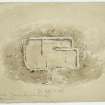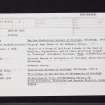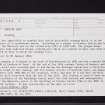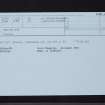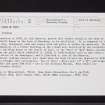Pricing Change
New pricing for orders of material from this site will come into place shortly. Charges for supply of digital images, digitisation on demand, prints and licensing will be altered.
Upcoming Maintenance
Please be advised that this website will undergo scheduled maintenance on the following dates:
Thursday, 9 January: 11:00 AM - 3:00 PM
Thursday, 23 January: 11:00 AM - 3:00 PM
Thursday, 30 January: 11:00 AM - 3:00 PM
During these times, some functionality such as image purchasing may be temporarily unavailable. We apologise for any inconvenience this may cause.
Loch Of Leys
Crannog (Period Unassigned)
Site Name Loch Of Leys
Classification Crannog (Period Unassigned)
Alternative Name(s) Loch Of Banchory
Canmore ID 36684
Site Number NO79NW 3
NGR NO 7046 9779
Datum OSGB36 - NGR
Permalink http://canmore.org.uk/site/36684
- Council Aberdeenshire
- Parish Banchory-ternan
- Former Region Grampian
- Former District Kincardine And Deeside
- Former County Kincardineshire
NO79NW 3 7046 9779.
Excavation in 1850, by J H Burnett, proved this former island in the Loch of Leys, formerly known as the Loch of Banchory, to be artificial. It is composed of layers of clay, brushwood, sand and stone, with oak piles to retain the material. The foundations of a former building on the island were destroyed by the excavation. This building known as the Castle of Leys, or the 'Gow' or 'Goo' House, possibly from the gulls which inhabited it, (NSA 1845) is traditionally said to have been a 14th century fortalice of the Wauchopes, and a 15th-16th century seat of the Burnets. Medieval cooking utensils were found when the Loch of Leys was drained in 1850 and the area brought into cultivation. Two of these - Brass pot, 11" x 9 1/2", and flagon, 9" with handle and spout (MA 6+7) - are in the National Museum. Four others are at Crathes Castle.
New Statistical Account (NSA) 1845; Name Book 1864; J H Burnett 1855; J Stuart 1866; National Museum of Antiquities of Scotland (NMAS) 1892.
It was impossible to examine this rarely accessible crannog which is in the centre of a treacherous marsh. According to a plaque in Crathes Castle, the home of the Burnetts was on the island from 1323 to 1550 AD. The plaque hangs above four medieval bronze cooking pots which are reputed to have come from the Loch of Leys in which the crannog lies.
Visited by OS January 1965.
A crannog is situated in the Loch of Leys (drained in 1850 and now a marsh) 400m NNW of Lochton of Leys. At the end of the 18th century 'ruins of houses, and of an oven' were recorded upon it and during the drainage operations a ' millstone' was found on the crannog, and five bronze vessels of medieval date, two dugout canoes (one 100m NNE of the crannog), coins, and part of a red deer skeleton were also recovered from the bed of the loch. The crannog is said to have been a residence of the Wauchope family until the 14th century and subsequently, of the Burnetts, prior to the building of Crathes Castle (3Km to the ESE) in the 16th century. It was inaccessible at the date of visit.
Statistical Account (OSA) 1793; J H Burnett 1855; J Stuart 1866; RCAHMS 1984, visited February 1983.
Listed.
Scottish Castle Survey 1988; N Bogdan and I B D Bryce 1991.
Excavation (29 February 2016 - 4 March 2016)
NO 70460 97790 Work was undertaken, 29 February – 4 March 2016, and began with a full topographical survey of the island that used DGPS to capture 2720 individual points with associated height data. A digital terrain
model was produced with this data that also surveyed the surviving extant medieval castle masonry. The results of the topographical survey have provided clearer insight into the former level of the loch and its relationship to the island which appears to have sunk by as much as 3m. The survey also demonstrated the level of survival of the upstanding medieval remains extant on the site which were first mapped by Burnett in 1850. The outline of the medieval tower house can still be clearly traced across the eastern half of the islet, but is less clear or absent along what Burnett sees as the western wall.
Excavation of a single 2 x 3m trench was undertaken that tested the nature of the surviving archaeology and obtained material for C14 dating. The excavation provided unambiguous evidence for the artificiality of the island, and also demonstrated surviving laid masonry below the former level of the loch capping the organic matrix of the artificial island. The excavation has characterised the preservation of the organic component of the site which has substantially deteriorated since the 1850 draining of
the loch and excavation of the crannog by Burnett. The main organic matrix of the crannog has been reduced to a deteriorated black mass with frequent bark fragment inclusions. A single highly degraded timber fragment was identified.
Two radiocarbon dates from the site have placed activity around the 1st–2nd centuries AD as well as in the 9th–10th centuries AD. The 1910±30 BP (Poz-83364) date came from small charcoal fragments within context (108), interpreted as an erosional layer sitting near the former surface of the water. This sat above the assumed medieval period laid stone capping [106] of the main organic mound (103). Within (108) a 15mm diameter fragment of mortar was found, and was initially thought to represent redeposited rubble material from the deterioration of the medieval tower house. The most likely explanation in light of the 1st-2nd-century AD charcoal date is that (108) is an erosional deposit, where the charcoal sampled was eroded out of the crannog mound and redeposited alongside the obviously medieval mortar.
The second date, 1095±30 BP (Poz-83362), came from context (103) the main core of the organic anthropogenic mound. This context was homogenous throughout, so samples were taken through the profile. This C14 date comes from a sample from the upper part of the profile, just below the laid stone capping [103].
Archive: NRHE and Archaeology Service for Aberdeen City, Aberdeenshire, Angus and Moray
Funder: Society of Antiquaries of Scotland, Archaeology Service for Aberdeen City, Aberdeenshire, Angus and Moray
Michael J Stratigos – University of Aberdeen
(Source: DES)











